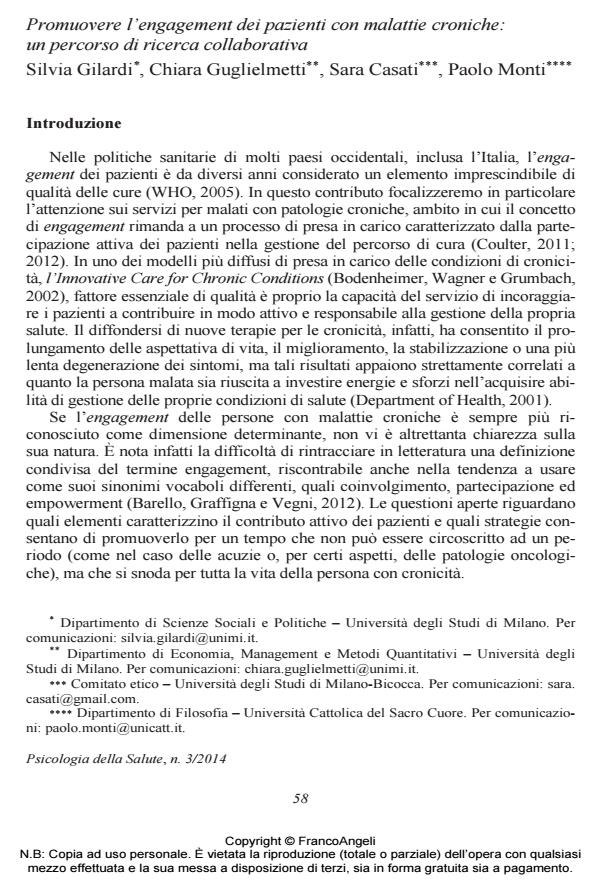Promuovere l’engagement dei pazienti con malattie croniche: un percorso di ricerca collaborativa
Titolo Rivista PSICOLOGIA DELLA SALUTE
Autori/Curatori Silvia Gilardi, Chiara Guglielmetti, Sara Casati, Paolo Monti
Anno di pubblicazione 2014 Fascicolo 2014/3
Lingua Italiano Numero pagine 22 P. 58-79 Dimensione file 138 KB
DOI 10.3280/PDS2014-003004
Il DOI è il codice a barre della proprietà intellettuale: per saperne di più
clicca qui
Qui sotto puoi vedere in anteprima la prima pagina di questo articolo.
Se questo articolo ti interessa, lo puoi acquistare (e scaricare in formato pdf) seguendo le facili indicazioni per acquistare il download credit. Acquista Download Credits per scaricare questo Articolo in formato PDF

FrancoAngeli è membro della Publishers International Linking Association, Inc (PILA)associazione indipendente e non profit per facilitare (attraverso i servizi tecnologici implementati da CrossRef.org) l’accesso degli studiosi ai contenuti digitali nelle pubblicazioni professionali e scientifiche
L’engagement dei pazienti è riconosciuto come un elemento essenziale per la qualità dei servizi per le patologie croniche. Il contributo si propone di esplorare le dinamiche socioorganizzate che favoriscono l’engagement dei pazienti e la loro trasformazione da consumatori passivi di cura a partner. Sarà presentata una ricerca collaborativa, realizzata con due servizi di un grande ospedale del Nord Italia, in cui pazienti e personale sanitario hanno cooperato per valutare e riorientare i percorsi diagnostico-terapeutici verso processi di lavoro partecipati centrati sul paziente. Strumenti di analisi delle pratiche sono stati l’analisi proattiva del rischio clinico (HFMEA) e l’analisi psicosociale degli snodi decisionali, applicati nell’ambito di focus group misti (pazienti, medici, infermieri, psicologi, assistenti sociali). I risultati hanno consentito di evidenziare l’intrecciarsi di aspetti clinici e organizzativi nelle rappresentazioni della natura dell’engagement e la sua caratterizzazione come un processo oscillante e instabile. Inoltre, attraverso l’analisi del processo d’indagine, è stato possibile identificare assunti e valori professionali che rischiano di dar vita ad una partecipazione apparente. La ricerca offre indicazioni per la progettazione di pratiche di gestione collaborativa dei percorsi di cura.
Parole chiave:Malattia cronica, engagement del paziente, ricerca collaborativa, focus group, HFMEA
- Health Care Services and the Coproduction Puzzle: Filling in the Blanks Maddalena Sorrentino, Chiara Guglielmetti, Silvia Gilardi, Marta Marsilio, in Administration & Society /2017 pp.1424
DOI: 10.1177/0095399715593317 - Co-production in the Public Sector Gaia Bassani, Cristiana Cattaneo, Giovanna Galizzi, pp.59 (ISBN:978-3-319-30556-1)
- Il trattamento psicoterapeutico nella Sindrome Fibromialgica: le applicazioni della terapia dinamica breve in un setting ospedaliero italiano Annunziata Romeo, Valentina Tesio, Benedetta Vicino, Fabrizio Colonna, Enrico Fusaro, Daniela Converso, Lorys Castelli, in PSICOLOGIA DELLA SALUTE 1/2019 pp.119
DOI: 10.3280/PDS2019-001007
Silvia Gilardi, Chiara Guglielmetti, Sara Casati, Paolo Monti, Promuovere l’engagement dei pazienti con malattie croniche: un percorso di ricerca collaborativa in "PSICOLOGIA DELLA SALUTE" 3/2014, pp 58-79, DOI: 10.3280/PDS2014-003004